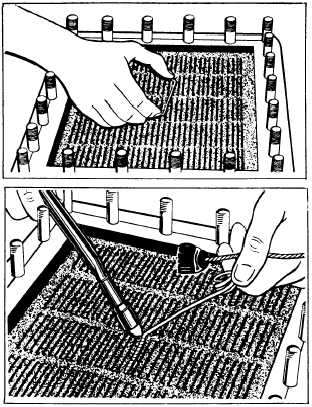121.33
Figure 3-13.—Emergency repair of a tube leak in a radiator
type heat exchanger.
should be replaced as soon as a leak develops, if
a replacement is available. The presence of one
leak, unless caused by dropping or accidental
puncture, indicates that other areas in the heat
exchanger may be eroded.
In shell-and-tube heat exchangers, a leaking
tube must be replaced as soon as possible. In an
emergency, a faulty tube may be blocked off by
inserting a special plug at each end, until the tube
can be replaced. An air lance or water lance
should be used to clean the tubes of a shell-and-
tube heat exchanger. If the scale has hardened in
the tubes, a round bristle brush or soft rubber
plugs may be used to clean the tubes. When clean-
ing the tubes by mechanical means, avoid
damaging the protective coating inside the tubes.
These tubes should never be polished, as the tar-
nish on the tubes acts as insulation to prevent
Chapter 3—ENGINE MAINTENANCE
further corrosion. Removing the tarnish will also
reduce the tube wall thickness and over a period
of time and a number of cleanings, could suffi-
ciently reduce tube strength, resulting in tube
failure. For the proper procedures for cleaning
shell and tube type heat exchangers and the
safety precautions, use the PMS maintenance
requirements cards, the manufacturer’s technical
manual and Naval Ships’s Technical Manual,
chapter 254.
LUBRICATING SYSTEM
To ensure that all the parts of an engine receive
adequate lubrication, it is essential that all parts
of the lubricating oil system be properly main-
tained at all times. Some parts which may be a
source of trouble are considered in this section.
For other information on lubricating systems, see
Engineman 3 & 2, NAVEDTRA 10541 (current
edition).
LUBE OIL PUMPS
Pumps used in engine lubricating systems are
of the positive displacement type. In some pumps
pressure control is maintained by pressure
regulating or pressure relief valves built directly
into the pump; in other pumps, valves exterior
to the pump are used for this purpose. Most
regulating devices recirculate excess lube oil back
to the suction side of the pump, but some pumps
discharge excess oil directly into the engine sump.
Pump casualties, as well as many other lube
systems failures, are indicated by the loss of lube
oil pressure. The loss of oil pressure can be
recognized by checking the pressure gages at
prescribed intervals, or by means of an electrical
alarm system. Most lube oil pump failures are
generally due to wear, and develop gradually.
Failures may also occur abruptly if a drive shaft
breaks, or some parts suffer physical deforma-
tion. Such failures are usually indicated by ab-
normal noise in the pump and by sounding of the
low-pressure lube oil alarm.
The warning system should be tested at
specified intervals, usually when an engine is
being started or secured. Warning systems do not
excuse personnel from their responsibility for
keeping a vigilant and accurate watch on engine
3-15



